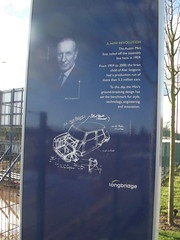Austin Mini
Commemorated on 1 plaque
A MINI REVOLUTION The Austin Mini first rolled off the assembly line here in 1959. From 1959 to 2000, the brain child of Alec Issigonis had a production run of more than 5.3 million cars. To this day, the Mini's ground-breaking design has set the benchmark for style, technology, engineering and innovation.
Austin Park, Longbridge, Birmingham, United Kingdom where it built (1959-2000)

_(8437745820).jpg?width=250)
